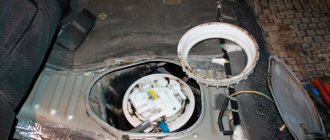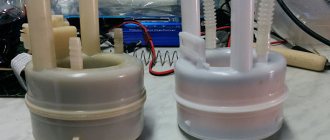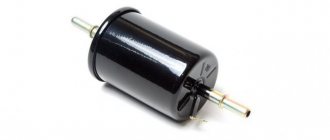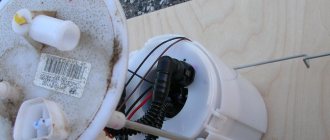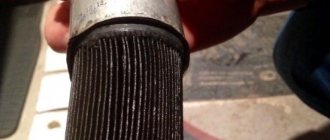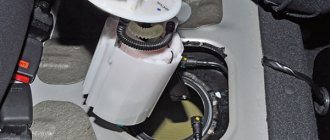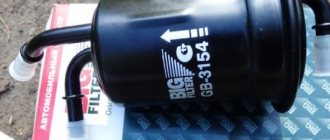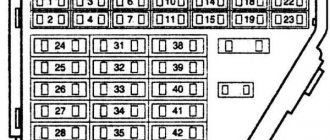Why do you need a fuel filter?
The fuel filter is designed to clean fuel from foreign impurities. Impurities end up in gasoline and diesel fuel due to leaks during transportation, pumping and storage, as well as due to the accumulation of insoluble compounds at the bottom of tanks, cans and car tanks. Solid and heavy impurities settle at the bottom of the car tank, but when driving over uneven surfaces, they float up and are captured by the fuel supply system.
In gasoline carburetor engines, foreign impurities in gasoline can clog the jets, thereby disrupting the ratio of the fuel-air mixture, which will lead to unstable engine operation.
In gasoline injection engines, foreign impurities can clog the injector nozzles, which will lead to disruption of proper fuel injection into the cylinders.
Diesel engines place higher demands on the quality of fuel filtration due to the increased sensitivity of diesel fuel equipment to clogging.
Most modern cars have two-stage fuel filtration. First, the fuel is cleaned of large contaminant particles by a coarse filter, then final filtration occurs by a fine filter.
A clogged fuel filter affects the behavior of the car, and problems appear gradually, first at engine operating modes with maximum instantaneous consumption while driving at high speeds and during intense acceleration, then with increasing filter clogging already at normal engine operating modes and even at idle. .
When the fuel filter becomes clogged, the engine begins to run out of fuel: it loses traction, the dynamics deteriorate when accelerating, the engine runs intermittently, and starts less easily.
If you don't change it in time..
All fuel passes through the filter, bringing with it any debris - dirt from outside, corrosion products, etc. Over time, the filter element becomes clogged and stops passing the required amount of fuel through it. Since the throughput drops, less fuel passes through it, and the pump still operates at the same performance, where will the excess gasoline go? That's right, it will increase the pressure in front of the filter and thereby increase the load on the pump, which will lead to its rapid wear.
A clogged filter will affect the injector by a drop in pressure in the rail, which will result in poor acceleration during hard acceleration and the gas pedal will not be as responsive as the first noticeable sign of a clogged fuel filter. And all because the mixture turns out to be lean, there will be insufficient fuel. Most likely, the oxygen sensor will show this and the “check engine” light will light up on the dashboard, you’ll have to go find out what kind of error this is, handy technicians will dismantle half the car because they don’t know that they do computer diagnostics with new spark plugs, a new fuel filter and normal pressure. ramp and a charged battery. Therefore, change the fuel filter on time.
Where is the fuel filter located?
The location of the fuel filter in a vehicle depends on the type of fuel system and vehicle model. You can get accurate information about the location of the fuel filter in your car in its operating instructions.
- For cars with carbureted gasoline engines, the fuel filter is usually located under the hood next to the carburetor. Most often, it has a transparent plastic body with a filter element inside. The transparent housing allows you to visually monitor the condition of the filter and the need to replace it.
- For cars with injection gasoline engines, the fuel filter can be installed under the hood, under the bottom of the car, or located in the fuel tank along with the fuel pump and the pre-filter in front of it.
- Diesel fuel filters are located under the hood between the high pressure fuel pump and the engine. Fuel filters for diesel engines have a more complex design because they must filter out water and paraffins contained in diesel fuel. To condense and remove water from diesel fuel, the filters include water sensors and drain plugs. Due to the paraffins contained in diesel fuel, which crystallize in the cold and quickly clog the filter element, fuel filters for diesel engines are often equipped with a heating system.
Types and principle of operation of the fuel purification system
The fuel filter design of a modern car assumes the presence of at least two degrees of purification. At the first stage, rough cleaning is carried out, during which large debris is eliminated. The second stage is fine cleaning with another filter, which is considered the main one. It is impossible to give a definite answer to the question of where the fine fuel filter is located, since its exact location depends on the car model and the type of fuel system implemented in it. But in any case, it is installed between the engine and the fuel tank, while a coarse filter is placed in the tank itself, even before the fuel pump.
Fuel filter device
The type of filter installed in the car depends on the type of fuel supply system, which can be:
- carburetor;
- injection;
- diesel
Fuel filters depending on the type of fuel system.
How often should you change the fuel filter?
The fuel filter needs to be replaced regularly. During the operation of the car, thousands of liters of fuel pass through the fuel filter, which brings a large amount of debris and dirt into the car's power system. Over time, the pores of the fuel filter element become clogged and it no longer performs its function properly, so it needs to be replaced.
The exact timing for replacing the fuel filter is set by the vehicle manufacturer and is indicated in the owner's manual.
Some automakers set the fuel filter replacement period for their cars at 30,000 kilometers, others at 120,000 kilometers. On average, most automakers set the fuel filter resource to 40-60 thousand kilometers.
The frequency of replacing the fuel filter depends not only on the mileage of the car, but also on the quality of the fuel, operating conditions, age of the car and driving style. Replacing the fuel filter is most often carried out as part of scheduled vehicle maintenance, but there are cases when the fuel filter has to be changed much earlier than scheduled due to symptoms of its clogging.
Fuel system types
Car fuel system diagram
To understand when it is necessary to change the filter device on a gasoline or diesel engine, you need to understand the types of fuel systems:
- Carburetor. These engines run on gasoline. Carburetor systems are considered obsolete and are one of the most complex in design. The purpose of the carburetor is to prepare the air-fuel mixture for the power unit. Carburetor systems have many subsystems that ensure this function is performed in different operating modes of the internal combustion engine. Despite all the disadvantages, such engines also have advantages. For example, low repair costs due to inexpensive fuel equipment components. Carburetor engines do not require the installation of high pressure pumps. The disadvantages are usually associated with ICE maintenance. Carburetor engines require constant maintenance. In the cold season, the engine must be configured correctly so that it can start without problems at low negative temperatures.
- Mono-injection. They are considered more modern systems, characterized by the presence of monophonic injection. Instead of a carburetor, it uses a spray device equipped with a single nozzle. Fuel atomization occurs when the power unit sucks in air currents. Mono-injection power systems are installed on engines running on gasoline. For optimal operation of the unit, a high pressure fuel pump and a return line are required. The system is also equipped with an engine control unit, which is used for the correct dosage of gasoline. The control module receives data from sensors of mass air flow, fuel pressure and others, as a result of which it configures the internal combustion engine for correct operation. Thanks to the use of monophonic injection, the design itself is more expensive compared to carburetor systems, but the unit starts easier at cold temperatures and is generally more stable. This allows you to reduce financial maintenance costs.
- Injection power systems with distributed injection. A more advanced engine option. Multipoint or distributor injection can be used. In such versions, the main shortcomings characteristic of older injection systems were corrected. Each cylinder of the power unit is equipped with injectors. In general, injectors have a similar principle of operation to the systems described above, but such engines are considered more environmentally friendly. Thanks to modernization, the designers managed to achieve stable operation of the unit and reduce fuel consumption; the cost of the systems was also increased.
- Injection internal combustion engines with direct injection. This type is considered one of the most perfect. In such engines, the process of atomizing the air-fuel mixture is carried out using nozzles mounted on each cylinder of the engine. Thanks to this, fuel consumption was reduced by 20% compared to systems with distributor injection. The designers were able to increase the technical parameters of the unit, including its power. The main disadvantage of such a system is its high cost, high demands on operation and the quality of the fuel being poured, as well as dependence on the use of different pumping devices. This is not just about the high pressure fuel pump.
- Diesel systems with a multi-section plunger pump. In it, fuel injection is carried out at the moment when the pump section delivers a portion of fuel. The pump itself is driven by the crank shaft. Such systems are not so demanding on the quality of the diesel fuel used, its cost is generally lower, but it is not as environmentally friendly. These systems are not equipped with a turbocharger, which can be attributed to disadvantages.
- Diesel systems with pump injectors. The advantages of improved engines include practicality and more reliable engine operation. If one of the cylinders breaks down, other devices continue to operate as usual. Each injector is equipped with its own pump, which makes it possible not to use overly long high-pressure fuel drives. But the cost of injectors is quite high, and these elements are classified as consumables, so they are also changed at certain intervals when they reach the end of their service life. Such systems are demanding on the quality of the fuel used.
- Common Rail. Such power systems are considered the most advanced; their use involves the use of a common ramp. The operating principle is similar to direct injection vehicles using gasoline. Common Rail power systems imply the presence of an electric high-pressure pumping device, with the help of which a pressure above 200 atmospheres is created in the lines. Electrical impulses supplied from the engine control unit open the injectors. The main advantages of the system include the high efficiency of the unit, reduced fuel consumption and a minimum amount of harmful substances in the exhaust gases, which makes the engines environmentally friendly. The disadvantages include the demands of engines on the quality of diesel fuel.
The ural biker channel showed how to change the fuel filter device in a Nissan Qashqai.
How to extend the life of your fuel filter
- Refuel only at large, trusted gas stations.
- Try not to pour fuel into the tank immediately after the gas station has drained the fuel from the tanker; the fuel is highly agitated and there is a higher chance of turbidity and dirt getting into your fuel tank.
- Do not fill your car's fuel tank with fuel from old, rusty cans.
- Change the fuel filter at the intervals specified in your vehicle's maintenance manual.
Signs of a clogged filter
Briefly about the symptoms that indicate the filter device is not working:
- The car's power unit began to work unevenly. The internal combustion engine “troits”, its speed either drops or increases.
- From time to time, especially when driving uphill, the car’s engine loses power and its traction decreases. To make up for power, the driver has to press the gas harder.
- If the car drives uphill at low speeds, the engine may stall. In this case, pressing the gas pedal will not produce results.
- If the car is equipped with an automatic transmission, then problems may arise in shifting gears. This is due to the fact that the internal combustion engine incorrectly transmits commands from the engine and shifts gears at the wrong time.
- Fuel consumption increases.
Procedure for replacing the fuel filter in a car with a diesel engine
The fuel filter for cars with a diesel engine is located under the hood. To find out the exact location of the filter, use your car's manual or look up information on the Internet.
After determining the location of the filter, disconnect the fuel hoses and electrical connectors of the water and heating sensor from it.
We unscrew the filter mount and remove the filter, carefully drain the remaining diesel fuel from the filter and fuel hoses into a prepared plastic container, which can be made from an old plastic canister by cutting off its side.
When replacing only the filter element (cartridge), the fuel filter is disassembled and a new filter element is installed in place of the old one.
Before installing a new filter in place, you must not leave the filter empty, as this may damage the high-pressure fuel pump (HPF) and injectors. Before installing the filter, you should pour 200 - 300 ml of diesel fuel into it; this can be done using a medical syringe or a special bulb.
Having filled the filter with diesel fuel, install it in place, connect the fuel hoses and electrical connectors.
We start the engine, let it run for a while, check the connections for fuel leaks.
Replacement process
Without the experience or knowledge to replace a part, you will harm the car system. Installing a fuel filter is a relatively simple process; if you follow the steps in the instructions, even a novice car enthusiast can handle it.
What to cook?
If the component is located under the bottom of the car, you will need to drive into the hole. Before removing it, prepare:
- a new cleaning element (buy those filters that are manufactured by the car manufacturer, or that are recommended to be installed);
- set of wrenches;
- slotted and Phillips screwdriver;
- rags.
Let's start replacing
The instructions describe the process of changing a non-separable fuel filter for any car. Depending on the design features of the transport, there may be some differences in the process. If your car has an element assembled with a fuel pump, we recommend that you read the recommendations from the manufacturer. Companies advise changing the filter along with the fuel pump.
- Decide on the location of the TF. In diesel and carburetor cars, the part is located in the engine compartment, either under the bottom or in the tank with a gas pump (in gasoline cars).
- Regardless of location, remove the fuel pump fuse and wait until the car stalls. This is done to remove pressure from the system.
- Now, to prevent fire during the replacement process, remove the negative terminal of the battery.
TF dismantling process - Then we look at the filter and determine the method of attachment to the gas line (the attachment can be inlet or outlet). Bolts or latches are used here, depending on the car. Remember in what order everything is located so as not to get confused when installing a new TF. If possible, take a photo with your phone of where the filter is installed. Don't forget about the location of the rubber seals and gaskets.
- Take the prepared rag and wrap it around the fuel cleaning element, as some gasoline will leak out of it. Using a Phillips screwdriver or wrench, remove the fuel filter from its mounting location. Now it can be removed.
Filter component installation - Install the new component in the same position in which the old one was installed (the arrow on the filter showing the directions of gasoline will help).
- Connect the gas line, checking the integrity of the pipe in advance. If the pipe is damaged, replace it.
- Now all that remains is to replace the fuel pump fuse and connect the battery terminals.
- Try starting the car. This may not work the first time because the pressure in the system has been released. Turn the ignition on for 30-60 seconds, then try to start.
Attention! Pay attention to safety precautions! When the fuel filter is being replaced, smoking is prohibited indoors. It is also advisable to ventilate the garage.
If the filter is in the fuel pump
On some car models, the filter may be located in the fuel pump housing.
In this case, replacement will not be possible, since such elements are simply not on sale. To get out of this situation, you can embed an ordinary filter in a plastic housing up to the fuel pump. This is done using tubes and pieces of rubber.
